
This isn’t your father’s NFL football stadium.
The two-year-oldCowboys Stadiumlocated in the Dallas suburb of Arlington, TX, is hands-down the Taj Mahal of professional sports stadiums in the United States.
The $1.15 billion facility, which plays host to next month’s Super Bowl XLV, can seat up to 100,000 fans. The stadium features a chic retractable roof, has 180-ft.-wide by 120-ft.-high glass retractable doors at each end zone and dazzles fans with a high-definition video board that measures 160 ft. long by 71 ft. high and runs half the length of the 100-yard field. Those glass doors are the largest in the world. The stadium also has the world’s longest single-span roof structure (two 1,225-ft. long steel arches).
So when it came to making sure the occupants and the facility itself were protected from fire hazards, having an elaborate fire sprinkler system installed was critical.
Greg Lee’s Dallas-basedDFW Fire Protection Inc., design engineered, built and installed the fire sprinkler systems in the stadium. DFW, which spent 2-1/2 years working at the stadium, is no stranger to involved fire sprinkler projects. It did the sprinkler work in Terminal D at Dallas-Fort Worth International Airport and is currently working on the system at the Irving (Texas) Convention Center.

Getting Started
DFW’sMark Cryerwas the project manager for the Cowboys Stadium job. For fire sprinkler installation purposes, he explains, the stadium was split into four quadrants with sectors being contained in each quadrant.“All of our standpipe (by Wheatland) was cut up into four quadrants and each had a central pipe fed up to the stairwell to feed the system,” he says. “We had a central fire pump (by Patterson) on the lowest level. We ran through the service corridor through the event level where we ran all of the standpipe. We had a standpipe loop from the fire pump back into the bottom of the stairwell and into the top-floor system. The pipe from the fire pump fed us a loop around the event level and off of that loop we fed into each stairwell.”
Cryer says approximately 4,000 Victualic concealed-head sprinklers were installed in the stadium (mostly Victaulic concealed pendant sprinklers; some Reliable brass upright sprinklers were also installed). Victaulic also supplied all the butterfly, check and dry valves. No sprinklers were installed in the seating area or around the giant video board due to functionality and practicality issues at higher elevations.
A total of 68 wet systems, one dry system (tunnel) and two electronic pre-action systems (in data centers and concourses) were installed.

Working Their Way Up
Cowboys Stadium features seven levels. Of those seven levels, five contain a total of 200 luxury suites - known as key revenue producers in this day and age of sports entertainment.“The main challenge for us was the oval shape of the stadium,” Cryer says. “There is not really anything square. Once we got the basic design down, we went from there and it went pretty well.”
Working on those suite levels presented some height challenges.
“On a lot of the suite levels, there wasn’t much room above the ceiling,” Cryer states. “In the field-level suites (where seating is located on top of the suite), the ceilings were a lot lower. We had to wrap a lot of pipe around the concrete tees on the beams. With some of the suites we had to put pipe in the walls because of the headroom.”
The use of flexible couplings in the stadium was also a hurdle DFW had to clear.
“We used a lot of flexible couplings (by Victaulic),” Cryer states. “As we got toward the outside of the building, things got wider. It was a challenge to keep everything straight. Once we got a system down, we were good.”
Aquaflex connections proved to be a major help throughout the installation process.
“Normally you hard pipe and you can’t hard pipe it until the ceiling grid is in because you have to get center of tile,” Cryer says. “The Aquaflex connections go from the pipe to the sprinkler head. We didn’t have to wait for finish-outs. We were able to test the system and then put the flex connector on the head. We probably use Aquaflex on every job. The connections and brackets are so easy to use compared to the way it used to be.”
Special attention had to be paid to the fire sprinkler cover plates.
“We did all of the custom colors on the cover plates,” Victaulic Regional Fire Protection ManagerMark Guerinsays. “It was quite a challenge to match up colors to the custom finishes.Jerry Jones(Cowboys owner) was very particular that the cover plates were to match up in those suites.”
Cryer and his team also had to use special care with the team’s famed star logo.
“When the players run through to get to the field there is that bar (Miller Lite Club) right there and that star hangs from the ceiling,” he explains. “They didn’t want the sprinkler head on the giant star.”
A different strategy had to be used for the stadium’s data rooms. Cryer and his crew installed several FM 200 open-nozzle systems there.
“FM 200 is a clean agent,” he notes. “It doesn’t use water. It sprays an agent where it doesn’t destroy computers and data processors. It’s standard practice.”

Sensor Security
To make sure the sprinklers are functioning to the highest level possible and protection for the occupants and the structure itself is maintained to the highest standards, DFW installed System Sensor Waterflow detectors throughout the building.“You have a flow and a tamperer for each system,” Cryer explains. “That way, the System Sensor reports back to the fire control room when there is an alarm. They get a signal saying system ‘so-and-so’ is flowing water. That tells them it could be a fire or it could be a leak. It will alert them to go check that system out.
The Postscript
Guerin gives Cryer and DFW major credit for how well the sprinkler project turned out.“We’re absolutely thrilled,” he says. “DFW understands how to install and test these systems and how to teach the owners how they work in their buildings.”
For Cryer, being able to work on his favorite NFL team’s stadium was quite the thrill.
“I was Cowboys born-and-raised between the good and the bad,” he says.
But his only focus during the job was protecting life and property.
“In the end, my goal is to control a fire,” Cryer says.




